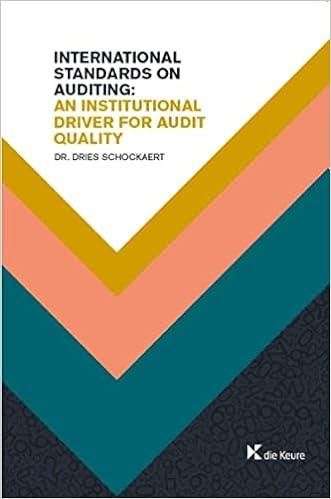What are these values? Thank you!




4 Scrappers Supplies tracks the number of units purchased and sold throughout each accounting period but applies its inventory costing method at the end of each period, as if it uses a periodic Inventory system. Assume its accounting records provided the following Information at the end of the annual accounting period, December 31. Units 230 Unit Cost $23 8.32/13 points awarded Transactions Beginning inventory, January 1 Transactions during the year: a. Purchase on account, March 2 b. Cash sale, April 1 ($39 each) C. Purchase on account, June 30 d. Cash sale, August 1 ($39 each) 25 370 (380) 280 (80) 29 Scored TIP: Although the purchases and sales are listed in chronological order, Scrappers determines the cost of goods sold after all of the purchases have occurred. eBook Required: 1. Compute the cost of goods available for sale, cost of ending inventory, and cost of goods sold at December 31 under each of the following inventory costing methods: (Round "Cost per Unit" to 2 decimal places.) a. Last-In, first-out. b. Weighted average cost. c. First-In, first-out. d. Specific Identification, assuming that the April 1 sale was selected one-fifth from the beginning inventory and four-fifths from the purchase of March 2. Assume that the sale of August 1 was selected from the purchase of June 30. 2. Of the four methods, which will result in the highest gross profit? Which will result in the lowest Income taxes? Complete this question by entering your answers in the tabs below. Reg 14 Reg 1B Reg 10 Reg 1D Reg 2A Reg 2B a. Compute the cost of goods available for sale, cost of ending inventory, and cost of goods sold at December 31 using the LIFO method. (Round "Cost per Unit" anwers to 2 decimal places.) LIFO (Periodic) Cost Units per Total Unit 230 S 23.00 $ 5,290 370 $ 25.00 280 s 29.00 650 17,370 22,660 880 Beginning Inventory Purchases March 2 June 30 Total Purchases Goods Available for Sale Cost of Goods Sold Units from Beginning Inventory Units from March 2 Purchase Units from June 30 Purchase Total Cost of Goods Sold Ending Inventory 280 28.00 380 $ 25.00 280 S 29.00 940 230 x 25,460 5,290 X Red text indicates no response was expected in a cell or a formula-based calculation is incorrect; no points deducted. Complete this question by entering your answers in the tabs below. Req 1A Reg 1B Req 1C Reg 1D Req 2A Req 2B b. Compute the cost of goods available for sale, cost of ending inventory, and cost of goods sold at December 31 using the Weighted average method. (Round "Cost per Unit" anwers to 2 decimal places.) Weighted Average Cost (Periodic) Units Total Cost per Unit $ 23.00 230 $ 5,290 370 $ 25.00 $ 29.00 280 Beginning Inventory Purchases March 2 June 30 Total Purchases Goods Available for Sale Cost of Goods Sold Ending Inventory 650 880 17,370 22,660 $ 17,550 $ 3,290 650 $ 27.00 230 *Red text indicates no response was expected in a cell or a formula-based calculation is incorrect; no points deducted. purchase of March 2. Assume that the sale of August 1 was selected from the purchase of June 30. 2. Of the four methods, which will result in the highest gross profit? Which will result in the lowest Income taxes? warded Complete this question by entering your answers in the tabs below. ed Reg 1A Reg 1B Reg 10 Reg 1D Reg 2A Reg 2B ok C. Compute the cost of goods available for sale, cost of ending inventory, and cost of goods sold at December 31 using the FIFO method. (Round "Cost per Unit" anwers to 2 decimal places.) FIFO (Periodic) Units Total Cost per Unit $ 23.00 230 $ 5,290 370 $ 25.00 $ 29.00 280 650 780 x 17,370 20,160 X Beginning Inventory Purchases March 2 June 30 Total Purchases Goods Available for Sale Cost of Goods Sold Units from Beginning Inventory Units from March 2 Purchase Units from June 30 Purchase Total Cost of Goods Sold Ending Inventory 230 270 $ 23.00 $ 25.00 $ 29.00 280 780 20,160 5,290 X 230 X * Red text indicates no response was expected in a cell or a formula-based calculation is incorrect; no points deducted. d. Specific identification, assuming that the April 1 sale was selected one-fifth from the beginning inventory and four-fifths from the purchase of March 2. Assume that the sale of August 1 was selected from the purchase of June 30. 2. Of the four methods, which will result in the highest gross profit? Which will result in the lowest Income taxes? arded Complete this question by entering your answers in the tabs below. Req 1A Reg 1B Reg 1C Reg 1D Req 2A Reg 2B d. CCompute the cost of goods available for sale, cost of ending inventory, and cost of goods sold at December 31 using the Specific identification method. Assume that the April 1 sale was selected one-fifth from the beginning inventory and four-fifths from the purchase of March 2. Assume that the sale of August 1 was selected from the purchase of June 30. (Round "Cost per Unit" anwers to 2 decimal places.) Show less Specific Identification (Periodic) Cost Units per Total Unit 230 S 23.00 $ 5,290 Beginning Inventory Purchases March 2 June 30 270 X $ 25.00 280 S 29.00 550 780 X 14,870 20,160 Total Purchases Goods Available for Sale Cost of Goods Sold Units from Beginning Inventory Units from March 2 Purchase Units from June 30 Purchase Total Cost of Goods Sold Ending Inventory 230 X $ 23.00 270 X $ 25.00 280 X 29.00 780 230 X 20,160 5,290 *Red text indicates no response was expected in a cell or a formula-based calculation is incorrect; no points deducted











